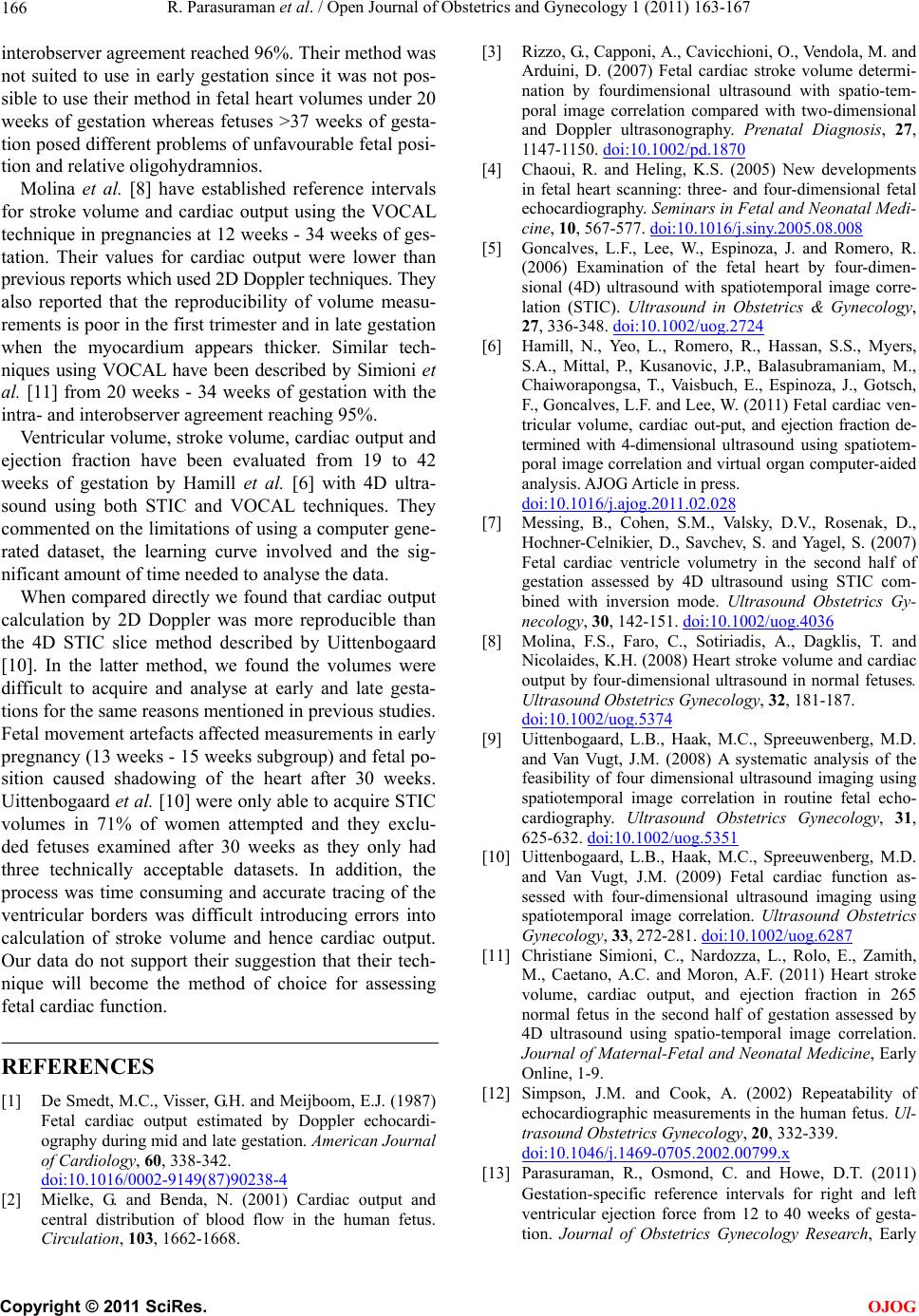
R. Parasuraman et al. / Open Journal of Obstetrics and Gynecology 1 (2011) 163-167
166
interobserver agreement reached 96%. Their method was
not suited to use in early gestation since it was not pos-
sible to use their method in fetal heart volumes under 20
weeks of gestation whereas fetuses >37 weeks of gesta-
tion posed different problems of unfavourable fetal posi-
tion and relative oligohydramnios.
Molina et al. [8] have established reference intervals
for stroke volume and cardiac output using the VOCAL
technique in pregnancies at 12 weeks - 34 weeks of ges-
tation. Their values for cardiac output were lower than
previous reports which used 2D Doppler techniques. They
also reported that the reproducibility of volume measu-
rements is poor in the first trimester and in late gestation
when the myocardium appears thicker. Similar tech-
niques using VOCAL have been described by Simioni et
al. [11] from 20 weeks - 34 weeks of gestation with the
intra- and interobserver agreement reaching 95%.
Ventricular volume, stroke volume, cardiac output and
ejection fraction have been evaluated from 19 to 42
weeks of gestation by Hamill et al. [6] with 4D ultra-
sound using both STIC and VOCAL techniques. They
commented on the limitations of using a computer gene-
rated dataset, the learning curve involved and the sig-
nificant amount of time needed to analyse the data.
When compared directly we found that cardiac output
calculation by 2D Doppler was more reproducible than
the 4D STIC slice method described by Uittenbogaard
[10]. In the latter method, we found the volumes were
difficult to acquire and analyse at early and late gesta-
tions for the same reason s mentio n ed in previou s stud ies.
Fetal movement artefacts affected measurements in early
pregnancy (1 3 weeks - 15 w eeks subgroup) and fetal po -
sition caused shadowing of the heart after 30 weeks.
Uittenbogaard et al. [10] were only able to acquire STIC
volumes in 71% of women attempted and they exclu-
ded fetuses examined after 30 weeks as they only had
three technically acceptable datasets. In addition, the
process was time consuming and accurate tracing of the
ventricular borders was difficult introducing errors into
calculation of stroke volume and hence cardiac output.
Our data do not support their suggestion that their tech-
nique will become the method of choice for assessing
fetal cardiac function.
REFERENCES
[1] De Smedt, M.C., Visser, G.H. and Meijboom, E.J. (1987)
Fetal cardiac output estimated by Doppler echocardi-
ography during mid and late gestation. American Journal
of Cardiology, 60, 338-342.
doi:10.1016/0002-9149(87)90238-4
[2] Mielke, G. and Benda, N. (2001) Cardiac output and
central distribution of blood flow in the human fetus.
Circulation, 103, 1662-1668.
[3] Rizzo, G., Capponi, A., Cavicchioni, O., Vendola, M. and
Arduini, D. (2007) Fetal cardiac stroke volume determi-
nation by fourdimensional ultrasound with spatio-tem-
poral image correlation compared with two-dimensional
and Doppler ultrasonography. Prenatal Diagnosis, 27,
1147-1150. doi:10.1002/pd.1870
[4] Chaoui, R. and Heling, K.S. (2005) New developments
in fetal heart scanning: three- and four-dimensional fetal
echocardiography. Seminars in Fetal and Neonatal Medi-
cine, 10, 567-577. doi:10.1016/j.siny.2005.08.008
[5] Goncalves, L.F., Lee, W., Espinoza, J. and Romero, R.
(2006) Examination of the fetal heart by four-dimen-
sional (4D) ultrasound with spatiotemporal image corre-
lation (STIC). Ultrasound in Obstetrics & Gynecology,
27, 336-348. doi:10.1002/uog.2724
[6] Hamill, N., Yeo, L., Romero, R., Hassan, S.S., Myers,
S.A., Mittal, P., Kusanovic, J.P., Balasubramaniam, M.,
Chaiworapongsa, T., Vaisbuch, E., Espinoza, J., Gotsch,
F., Goncalves, L.F. and Lee, W. (2011) Fetal cardiac ven-
tricular volume, cardiac out-put, and ejection fraction de-
termined with 4-dimensional ultrasound using spatiotem-
poral image correlation and virtual organ computer-aided
analysis. AJOG Article in press.
doi:10.1016/j.ajog.2011.02.028
[7] Messing, B., Cohen, S.M., Valsky, D.V., Rosenak, D.,
Hochner-Celnikier, D., Savchev, S. and Yagel, S. (2007)
Fetal cardiac ventricle volumetry in the second half of
gestation assessed by 4D ultrasound using STIC com-
bined with inversion mode. Ultrasound Obstetrics Gy-
necology, 30, 142-151. doi:10.1002/uog.4036
[8] Molina, F.S., Faro, C., Sotiriadis, A., Dagklis, T. and
Nicolaides, K.H. (2008) Heart stroke volume and cardiac
output by four-dimensional ultrasound in normal fetuses.
Ultrasound Obstetrics Gynecology, 32, 181-187.
doi:10.1002/uog.5374
[9] Uittenbogaard, L.B., Haak, M.C., Spreeuwenberg, M.D.
and Van Vugt, J.M. (2008) A systematic analysis of the
feasibility of four dimensional ultrasound imaging using
spatiotemporal image correlation in routine fetal echo-
cardiography. Ultrasound Obstetrics Gynecology, 31,
625-632. doi:10.1002/uog.5351
[10] Uittenbogaard, L.B., Haak, M.C., Spreeuwenberg, M.D.
and Van Vugt, J.M. (2009) Fetal cardiac function as-
sessed with four-dimensional ultrasound imaging using
spatiotemporal image correlation. Ultrasound Obstetrics
Gynecology, 33, 272-281. doi:10.1002/uog.6287
[11] Christiane Simioni, C., Nardozza, L., Rolo, E., Zamith,
M., Caetano, A.C. and Moron, A.F. (2011) Heart stroke
volume, cardiac output, and ejection fraction in 265
normal fetus in the second half of gestation assessed by
4D ultrasound using spatio-temporal image correlation.
Journal of Maternal-Fetal and Neonatal Medicine, Early
Online, 1-9.
[12] Simpson, J.M. and Cook, A. (2002) Repeatability of
echocardiographic measurements in the human fetus. Ul-
trasound Obstetrics Gynecology, 20, 332-339.
doi:10.1046/j.1469-0705.2002.00799.x
[13] Parasuraman, R., Osmond, C. and Howe, D.T. (2011)
Gestation-specific reference intervals for right and left
ventricular ejection force from 12 to 40 weeks of gesta-
tion. Journal of Obstetrics Gynecology Research, Early
C
opyright © 2011 SciRes. OJOG